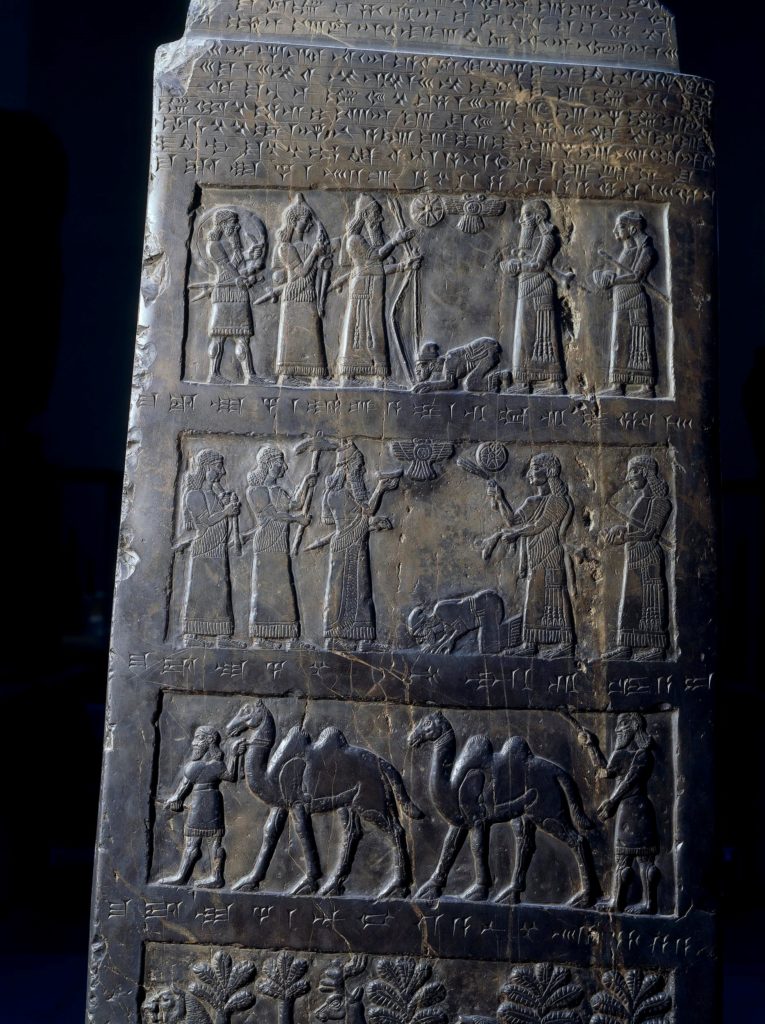Today’s post is by Dr. Mathias Winkler, who studied Catholic Theology and Jewish Studies in Tuebingen and Jerusalem (2008-2013), before receiving his Doctorate in Hebrew Bible/Old Testament from Tuebingen University in 2016. He taught at the Faculty of Theology in Trier and, since 2017, is Assistant Professor at the Department for Catholic Theology at Siegen University in Germany. (Twitter @the_winkler)
The Bible did not fall out from the blue sky. It is deeply rooted in its cultural environments dating back thousands of years, but it is still an important guide for many people today. I was astonished when I took a closer look at the story of Lot in Gen 19:30-38 getting raped by his two daughters. I was even more astonished when I browsed through the bookshelf, that almost no commentator (male or female), called it rape:[1] intoxication followed by rape, intentional and premeditated.
Why do so many scholars hesitate to call this rape? Maybe, there is still the notion that “real men” cannot be raped, especially not by women. Maybe, we still think of masculinity as a monolithic and clear-cut concept where a man penetrates but does not get penetrated or sexually abused. (The mindset would be: There is just one kind of masculinity and everything else is femininity.) Maybe, we are still complicit in upholding such a concept of masculinity. And when I say “we,” I mean theologians and scholars of the Bible, as well as teachers and preachers. Are we complicit by legitimating this image of “real men” with our readings of biblical texts?
Do we think that in ancient times and cultures, there was no such thing as sexual violence and humiliation directed against men – and, therefore, maybe we hesitate to call Lot the victim of rape? I want to take a short socio-historical view on masculinities, sexual humiliation and violence done to men in the Hebrew Bible and its cultural environment. Are there connections and if so, how can they be described? Did the ancients even think about that connection? Why did they and how? What can we learn about historical masculinities from ancient texts and pictures and what is the connection with sexual humiliation and violence experienced by men? To begin to grapple with such large and important questions, today, I want to share a small piece with you.
I want to take a look at a picture from the Ancient Near East which shows the connection between the rivalry of masculinities and sexual humiliation. Scholars of the Ancient Near East and the Hebrew Bible are familiar with the so-called “black obelisk,” which was erected under the Assyrian King Shalmaneser III, who reigned ca. 858-824 BCE. This obelisk (erected in 825 BCE) is today in the British Museum. A small part of it shows the Israelite King Jehu, depicted in the Hebrew Bible (2 Kings 9-10), as bowing to the ground before the Assyrian king, who stands tall and straight (see the picture, second register from the top). Around the two kings stand beardless men, eunuchs who serve at the Assyrian royal palace and in the administration. Two details are interesting, and both concern the connection of masculinities and sexual humiliation.

Picture: CC-BY-NC-SA 4.0 © The Trustees of the British Museum
The first detail: Jehu touches the ground with his beard before the Assyrian king. He seems to brush and clean the floor in front of the upright Assyrian king. Beards are heavily laden with masculine associations. A beard is not just a bunch of facial hair but also a secondary male sexual characteristic. Therefore, Jehu is forced to humiliate himself with one of those parts of his body that make him a “masculine” man. Of course, his beard is shorter than the Assyrian king’s, showing the male hierarchy: “the more beard, the more man”. Cleaning the floor before the king with one’s beard is also attested in written records as a gesture of submission (Parpola, 1987, p. 6). The beardless eunuchs, who seem to represent a kind of third gender, stand up tall. The ones who don’t show male facial hair are in a superior position to the Israelite king. Is Jehu even less “male” than a eunuch?
The second detail: This bodily posture (cleaning the floor with his beard) forces the Israelite king to show and display his bottom in a way that is pronounced, even ostentatious. In the picture it is the highest point of his body. It seems to the spectator that he is offering his bottom to the other men around him – not only to the Assyrian king but also to the eunuchs, which seems quite odd, demeaning and bizarre. He is ready for penetration – even by eunuchs.
There are three kinds of men depicted on the obelisk (Assyrian King, Israelite King, eunuchs), all assuming different postures and offering different “presentations” of their “masculinities”. The masculinities displayed are not equal at all. The spectrum is hierarchical, and it works with attributes and properties of the male body, which are laden with sexual association (beard, bottom, upright position like an erect phallus). Foreign policies are mixed with a hierarchy of masculinities that is established via sexual humiliation and shaming.
This picture is not singular. There are many other images from the Ancient Near East and Egypt which show competing masculinities in contexts of sexual humiliation. The motif of naked male captives, their arms tied on their backs so their naked and exposed genitalia are visible, is very commonplace. A group of these tied up captives is sometimes led by a victorious soldier in uniform carrying his sword or bow (both esteemed symbols signifying a strong and powerful hegemonic masculinity, because both weapons penetrate the male enemy body). This motif is constant throughout centuries. Where wall reliefs show the conquest of a city, we often see naked male bodies impaled – a kind of visual penetration. Allusions to the sexual humiliation of other men seem to be a very “popular” and common iconographic theme, particularly in imperial contexts. It seems to be a “normal” part of foreign policy to humiliate other men sexually. Such humiliation forms part of military campaigns and of the propaganda in their aftermath.
In written records, too, threatening the other party’s masculinity and bodily integrity in a sexual way is part of imperial propaganda. Hence, in Assyrian Vassal Treaties, the vassal’s masculinity is threatened and slighted. The following quote is from a treaty between Assyrian King Aššur-Nerari V, who reigned from 754-745 BCE (he is setting the conditions) and Matiʼ-ilu, King of Arpad (who has nothing to say at all):
“If Matiʼ-ilu sins against this treaty with Aššur-Nerari, king of Assyria, may Matiʼ-ilu become a prostitute, his soldiers women, may they receive [a gift? salary?] in the square of their cities like any prostitute […]” (Parpola and Watanbe, 1988, p.12)
This kind of rhetoric establishes a hierarchy of masculinities via sexual humiliation – as in the images discussed above. There is an example from the Hebrew Bible, too, in which King David curses the masculinity of the House of his former ally Joab (2 Sam 3:29): “It may fall on the head of Joab and his house. There shall not be one missing in the house of Joab who has a running sore or is struck with a skin disease or who holds the spindle or shall be struck down by the sword or who lacks food.” The men shall hold the spindle: this signifies femininity; the men of Joab’s house shall be turned into women. Similarly, defeated soldiers in battle are said to have become women (Jer 51:30).
The frequency of such iconographical and rhetorical motifs is astonishing. Furthermore, at that time it seems to have been “normal” (or acceptable) to display and utter these motifs – at least in imperial contexts and in royal propaganda. In those contexts, it was “normal” to portray the enemy or the other party as “less male”, sometimes as feminized or demasculinized (with a mindset in the background that we today call heteronormativity). It was “normal” and okay to sexually humiliate and to rape subjugated or enemy males (in texts, in pictures … also in real life?) because “we”, the superior party, are “more male”. The rape of a man in this scheme establishes the superior masculinity of the rapist. It also diminishes the masculinity of the raped man. Masculinity is zero-sum.
There is one more surprising thing: We see pictures of naked men, tied up in an exposing posture or impaled; we see humiliated men cleaning the floor with their beards. But where are the women? Women were kidnapped, humiliated and raped in ancient warfare (as in warfare still today).[2] But why are the ancient sources so silent about this? It seems to be “okay” to show sexual humiliation of men but not of women. Why is that? Is it more “normal” to picture and verbally describe sexual humiliation of men?
Cynthia Chapman describes another feature of hegemonic masculinity in the Ancient Near East: the ability to care for one’s family and household, especially for women and children. The superior party, which threatens and humiliates other men, does not threaten or humiliate women and children – at least in the virtual propaganda. This way, they show that they – again – are more “masculine”: because they can provide for and protect women and children – whereas the threatened and humiliated enemy “men” cannot and are therefore less “masculine”. The silence about humiliated or raped women is a means of communication between competing masculinities (Chapman, 2004, pp. 46-47.) The suffering of women and children is erased not because it does not take place but in order to establish a higher degree of “masculinity” by threatening and humiliating men. This is, essentially, a case of “taking it up a notch:” a very powerfully masculine man can even rape and feminize other men.
Texts, but especially pictures, are ways of communication that proliferate ideas and concepts in a short and abbreviated style. But who was the sender and who was the addressee? What kind of impact was envisaged? A superior party, who thought of itself as having superior masculinity showed its superiority towards another party, which might be regarded as a potential rival or as a possible threat, through sexual humiliation. Propaganda is necessary to keep dangerous parties quiet and under control: you don’t need propaganda to control the harmless. The media proliferating sexual humiliation and masculine contests aim to keep things clear: “We are more powerful and more masculine than you. If you try to rebel, we will show you that you are not men.” So, the foreign defeated king Jehu, prostrating himself before the Assyrian king, signals to the spectator an example of what could happen to him. The third party involved, the spectator, the recipient, poses a danger or threat to the sender’s superior masculinity and power.
But there is not just a communication “ad extra” but also “ad intra” in those texts and pictures. What did a victorious soldier think, when he saw a defeated, maybe tied up, enemy soldier in front of him? He was told: “Those are not real men.” Does the soldier think of his defeated enemy as someone whom he can humiliate and, perhaps, rape? Was it, therefore, “normal” for him to abuse captive male enemies?
One could say today that it was “just” propaganda in texts and pictures without any link to “real” life. On the one hand, it is still today a widespread phenomenon to sexually humiliate and to rape male and female enemies. On the other, there had to be a link to “real life” experiences of sexual humiliation or humiliating practices: otherwise, recipients would not understand the message. This could have been something experienced by both men and women. At the very least, there had to have been a notion of things one ought not to do to a “real man” in a sexual way. Furthermore, when we today say: “It was just propaganda” we are complicit in this propaganda. We do not take seriously the real outcomes of the propaganda and its basis in real life. We do not take seriously the suffering of victims of sexual violence and humiliation, aided and abetted by the propaganda rooted in hegemonic hypermasculinity.
The Hebrew Bible emerged in such a cultural environment. There are traces of hegemonic hypermasculinity in the Hebrew Bible, which is today a holy scripture and a guide to life for so many people. It also, sometimes, becomes a guide for “biblical manhood” or how to be a “real” man. It is therefore necessary to look for these traces that connect discourses about masculinities with sexual humiliation and to analyse them in their historical context.
We can see how different masculinities compete with each other in the Bible and what kinds of men and masculinities are suppressed, oppressed, suffer violence and are silenced. We can criticize masculine ideals in the Hebrew Bible when they are used to subjugate other men and their masculinities. We can see behind the curtains of power-related male gender hierarchies in the Bible. This helps us speak responsibly and sensitively about biblical masculinities, with the necessary caution not to be complicit with oppressive gender constructions. We can also recognize the broad spectrum of masculinities in antiquity, which helps us to break with a monolithic concept of masculinity in our own contemporary cultures. We see how holy scripture is still complicit today in keeping masculinity as a monolithic and unchangeable block that negates other kinds of lived masculinities. We can do something about it, starting with exposing these dangerous power structures and then resisting and dismantling them.
References
Chapman, Cynthia. 2004. The Gendered Language Of Warfare In The Israelite-Assyrian Encounter. Winona Lake: Harvard Semitic Museum Publications 62.
Parpola, Simo. 1987. The Correspondence of Sargon II, Part I Letters from Assyria and the West. Helsinki University Press: The State Archives of Assyria.
Parpola, Simo, and Watanabe, Kazuko (eds.). 1988. Neo-Assyrian Treaties and Loyalty Oaths. Helsinki University Press: State Archives of Assyria (Vol. II).
[1] One prominent exception is Susanne Scholz, Sacred Witness: Rape in the Hebrew Bible (Fortress Press, 2010). Another is Rhiannon Graybill, ‘Focus on Teaching About Sexual Violence in the Hebrew Bible’, available online (see here).
[2] For a powerful recent discussion on this, see Christina Lamb, Our Bodies, Their Battlefield: What War Does to Women (William Collins, 2020).






